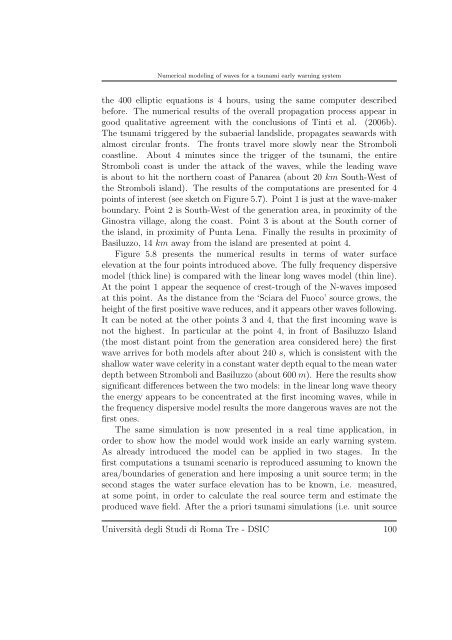Numerical modeling of waves for a tsunami early warning system
Numerical modeling of waves for a tsunami early warning system
Numerical modeling of waves for a tsunami early warning system
Create successful ePaper yourself
Turn your PDF publications into a flip-book with our unique Google optimized e-Paper software.
<strong>Numerical</strong> <strong>modeling</strong> <strong>of</strong> <strong>waves</strong> <strong>for</strong> a <strong>tsunami</strong> <strong>early</strong> <strong>warning</strong> <strong>system</strong><br />
the 400 elliptic equations is 4 hours, using the same computer described<br />
be<strong>for</strong>e. The numerical results <strong>of</strong> the overall propagation process appear in<br />
good qualitative agreement with the conclusions <strong>of</strong> Tinti et al. (2006b).<br />
The <strong>tsunami</strong> triggered by the subaerial landslide, propagates seawards with<br />
almost circular fronts. The fronts travel more slowly near the Stromboli<br />
coastline. About 4 minutes since the trigger <strong>of</strong> the <strong>tsunami</strong>, the entire<br />
Stromboli coast is under the attack <strong>of</strong> the <strong>waves</strong>, while the leading wave<br />
is about to hit the northern coast <strong>of</strong> Panarea (about 20 km South-West <strong>of</strong><br />
the Stromboli island). The results <strong>of</strong> the computations are presented <strong>for</strong> 4<br />
points <strong>of</strong> interest (see sketch on Figure 5.7). Point 1 is just at the wave-maker<br />
boundary. Point 2 is South-West <strong>of</strong> the generation area, in proximity <strong>of</strong> the<br />
Ginostra village, along the coast. Point 3 is about at the South corner <strong>of</strong><br />
the island, in proximity <strong>of</strong> Punta Lena. Finally the results in proximity <strong>of</strong><br />
Basiluzzo, 14 km away from the island are presented at point 4.<br />
Figure 5.8 presents the numerical results in terms <strong>of</strong> water surface<br />
elevation at the four points introduced above. The fully frequency dispersive<br />
model (thick line) is compared with the linear long <strong>waves</strong> model (thin line).<br />
At the point 1 appear the sequence <strong>of</strong> crest-trough <strong>of</strong> the N-<strong>waves</strong> imposed<br />
at this point. As the distance from the ‘Sciara del Fuoco’ source grows, the<br />
height <strong>of</strong> the first positive wave reduces, and it appears other <strong>waves</strong> following.<br />
It can be noted at the other points 3 and 4, that the first incoming wave is<br />
not the highest. In particular at the point 4, in front <strong>of</strong> Basiluzzo Island<br />
(the most distant point from the generation area considered here) the first<br />
wave arrives <strong>for</strong> both models after about 240 s, which is consistent with the<br />
shallow water wave celerity in a constant water depth equal to the mean water<br />
depth between Stromboli and Basiluzzo (about 600 m). Here the results show<br />
significant differences between the two models: in the linear long wave theory<br />
the energy appears to be concentrated at the first incoming <strong>waves</strong>, while in<br />
the frequency dispersive model results the more dangerous <strong>waves</strong> are not the<br />
first ones.<br />
The same simulation is now presented in a real time application, in<br />
order to show how the model would work inside an <strong>early</strong> <strong>warning</strong> <strong>system</strong>.<br />
As already introduced the model can be applied in two stages. In the<br />
first computations a <strong>tsunami</strong> scenario is reproduced assuming to known the<br />
area/boundaries <strong>of</strong> generation and here imposing a unit source term; in the<br />
second stages the water surface elevation has to be known, i.e. measured,<br />
at some point, in order to calculate the real source term and estimate the<br />
produced wave field. After the a priori <strong>tsunami</strong> simulations (i.e. unit source<br />
Università degli Studi di Roma Tre - DSIC 100

















